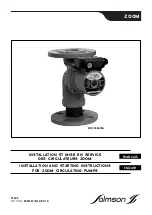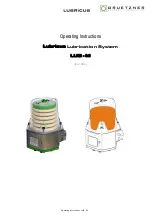
DynaQuip Contols
10 Harris Ind. Pk., St. Clair, MO 63077 • 800-545-3636 • www.watercop.com
Compression Fittings
The unit can be installed with compression fittings
using common household tools and basic mechanical
ability. You will need:
a) 2 fittings (male pipe thread x compression) available
at most local hardware or plumbing supply stores
b) Teflon tape or other thread sealant
c) Tubing cutter
d) Ruler
e) Pencil or marker
f) 2 large adjustable wrenches
Measure the outside diameter of the copper tube and
note the valve size to be sure you purchase the proper
size fittings for the job.
1. Remove nuts and sleeves from compression
fittings and install the fittings into each end of the
valve using Teflon tape or other thread sealant to
ensure a watertight seal. Hold one wrench on flats
of valve body and use the other to tighten fittings.
2. Measure the distance from end to end of valve
assembly. For 1/2” tube (5/8 outside diameter)
subtract 1/2”, for 3/4” tube (7/8 outside diameter)
subtract 3/4” from your measurement. This is the
length of the section of tubing to be cut out of the
existing line. The piece of existing tubing to be cut
out is shorter than the measured length so that
tube ends extend into the compression fittings.
3. Select the location for the WaterCop
®
PRO. Be
sure to consider that you will need access to the
front panel of the control unit. After cutting the
section of tube out of the line, you will need to shift
the tube ends to be able to fit the unit into place.
Make sure you will have access and room to adjust
before you cut the tube.
4. Mark the tube in the location you have selected.
Double check the length and location you marked.
5. Turn water off and drain the system.
6. Use tube cutter to cut copper tube at the locations
you marked. Careful, there will probably still be
some water in the line.
7. Remove any burrs from the tube ends and clean
ends.
8. Install compression nuts and sleeves to each tube
end.
9. Shift tube ends to install WaterCop
®
PRO valve in
line.
10. Position the unit and tighten compression nuts.
Hold the fitting with one wrench while tightening
the nut with the other. Tighten both nuts.
11. Plug unit into a proper power source and turn valve
to open position (open button / green light).
12. Unplug unit, turn water back on and carefully
check for leaks.
13. Tighten fittings if needed to stop any leaks.
14. Plug unit back into power source. Installation is
complete.
8
192261 revC
Solder Fittings
An alternative method is to solder the unit into the
water line. This method requires a considerably higher
skill level to accomplish the installation properly and
safely. If you are not skilled in this area, it is strongly
recommended that you contact a professional plumber
to do this type of installation.
Electrical Connection
The WaterCop
®
PRO is supplied with a power adaptor.
Consult local electrical codes as to the necessity of
ground fault protection. It is recommended that the
WaterCop
®
PRO not be plugged into an extension cord.
Review “Specification” current and power requirements
as not to overload the circuit supplying power.
Warnings and Precautions
WARNING
The motorized drive unit case is not capable of
supporting any loads. Do not attempt to use the unit as
a step. This will cause damage to the unit and could
cause personal injury. Do not store highly flammable
items such as oily rags or other combustibles near your
WaterCop
®
PRO.
CAUTION
It is recommended that eye protection be worn while
installing or servicing the system. Failure to do so could
result in personal injury.
CAUTION
Do not use the case as leverage when mounting this
unit or tightening fittings. Apply wrench to flats on the
valve body to tighten fittings. Changing Digital Codes
Emergency Procedures
In the unlikely event that the WaterCop
®
PRO System
should shut off the main water supply and then become
inoperable due to a power outage or damage, it is
possible to manually operate the WaterCop
®
PRO to
return water service. Unplug the WaterCop
®
PRO from
its power source. The valve may be manually opened
by means of the manual override handle.


























